
Saunderstown is a small village and historic district in the towns of Narragansett and North Kingstown in Washington County, Rhode Island, United States. Saunderstown has its own post office with the ZIP Code of 02874, which also includes a small part of South Kingstown. Its population is 6,245.

Carolina is a village that straddles the border of the towns of Charlestown and Richmond on the Pawcatuck River in Washington County, Rhode Island. Rhode Island Route 112 passes through the village. Carolina is identified as a census-designated place, with a population of 970 at the 2010 census.

The William Mowry House is an historic farm house on Farnum Pike in North Smithfield, Rhode Island. It is a 2+1⁄2-story plank-framed house, five bays wide, with a gable roof and a large central chimney. The main entrance is centered on the main (south-facing) entry, and is enclosed within a single-story hip-roof vestibule of 20th-century construction. A small single-story ell extends to the west of the main block. The interior follows a typical center-chimney plan, with the kitchen and parlor in the front of the house, and the dining room flanked by a small pantry and bathroom in the rear. The house was built c. 1802-05 by William Mowry, whose family has owned land in the area since the 17th century.
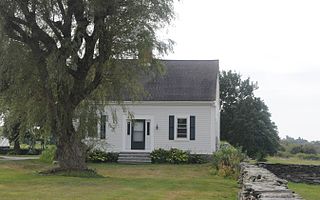
The Bailey Farm is an historic farm at 373 Wyatt Road in Middletown, Rhode Island. Now reduced from more than 100 acres (40 ha) to about 45 acres (18 ha), the farm is a well-preserved example of a 19th-century island farm. It was owned by members of the Bailey family, possibly as early as the late 17th century, into the 19th century. The original main house appears to be a mid-18th century structure that was given a significant Greek Revival treatment in the 19th century. It is a 1-1/2 story Cape style house, three bays wide, with a central chimney. The main entrance is centered on the northern facade, and is flanked by sidelight windows and pilasters, with an entablature above. The corners of the building are pilastered. A series of outbuildings stand nearby. There is a second complex of buildings on the northwest part of the property, built in the 1930s near the location of the Bailey family cemetery.

The Andrews–Luther Farm is a historic farm in Scituate, Rhode Island. It is located on the south side of Elmdale Road, a short way east of its junction with Harmony Road. The farm is a 45-acre (18 ha) property, with its main house, a c. 1768 wood-frame structure set near the road. It is 2+1⁄2 stories high, with a large central chimney, and a center entry on the south facade with vernacular Greek Revival styling. A corn crib dating to the late 19th or early 20th century stands further south on the property, and the foundational remains of older buildings dot the area. The farm is distinctive for retaining a large portion of its original setting, and for the detailed accounts of it which have been retained by Harley Luther's descendants.
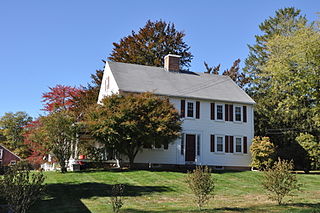
The Amos Cook House is an historic house in Scituate, Rhode Island. Built in 1812, it is a 2+1⁄2-story wood-frame structure, five bays wide, with a large central chimney. The center entry is framed by a Greek Revival surround that was a later alteration, and there is a shed-roof porch extending along the southern (left) facade. The house has retained much of its interior woodwork. The house was built by Augustus and Carver Hopkins, members of Rhode Island's prominent Hopkins family. It was purchased, along with a number of farm outbuildings, by Amos Cook in 1865, and was converted into a summer residence in the early 20th century.
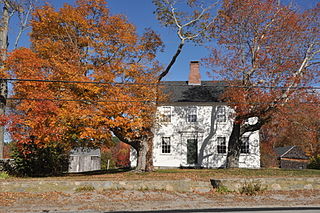
The Maton–Hunt–Farnum Farm is an historic farm on Putnam Pike in Glocester, Rhode Island. The main house is a 2+1⁄2-story wood-frame structure, five bays wide, with a gable roof and a central chimney, and is set on the north side of Putnam Pike. Behind the house are a number of farm outbuildings, including two barns, henhouses, a corn crib, and a privy. Built c. 1793 by Daniel Manton, the house exhibits fine Federal styling both inside and outside.
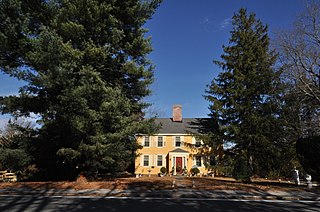
The Whipple–Cullen House and Barn is an historic farmstead on Old River Road in Lincoln, Rhode Island. The main house is a 2+1⁄2-story wood-frame structure, five bays wide, with a large central chimney and a gable roof. An addition extends to the rear, and a 19th-century porch is on the side of the house. The barn, dating to the late 19th century, is north of the house, and there is a former farm shed, now converted to a garage, to its south. The property is located across the street from the Lincoln town offices. The house, built c. 1740, is one of the town's least-altered 18th century houses, and the barn is a rare survivor of the town's agrarian past.

The Todd Farm is an historic farm at 670 Farnum Pike in North Smithfield, Rhode Island, US. The farm includes a house dating to 1740, as well as a collection of outbuildings dating to the early 20th century. The main block of the house is a 2+1⁄2-story wood-frame structure, five bays wide, with a gable roof and a large central chimney. The main block has been added to numerous times, with full-size additions to both sides as well as a sloping addition to the rear, giving the house a saltbox appearance in the rear and a total width of 11 bays. Behind and beside the house are arrayed a number of small outbuildings, and a barn which has been converted into residential space. The house was probably built by Noah Smith around 1740, around the time he established a sawmill on Cherry Brook, which runs behind the house and is dammed to form Todd Pond.

The Allen–Madison House is a historic house on Marine Road in North Kingstown, Rhode Island. It is located on the grounds of the former Davisville Naval Construction Battalion Center, set on an isolated plot apart from the main portion of the base.

The Henry Eldred Farm is an historic farm complex at 368 Old North Road in South Kingstown, Rhode Island. The main block of the farmhouse, a 2+1⁄2-story wood-frame structure, was probably built c. 1822, although there is architectural evidence suggesting it may be an enlargement of an older structure. Its simple Federal styling is distinctly rural and vernacular in character. The complex also includes a cluster of buildings dating to the mid-19th century, including a barn, carriage house, shed, and blacksmith shop.

The Kingston Hill Farm, also known as the Potter-Peckham Farm, is a historic farm in South Kingstown, Rhode Island. The 20-acre (8.1 ha) farm is centered on a building complex with a c. 1810 1+1⁄2-story wood frame farmhouse, which follows a typical plan of five bays with a central chimney. Behind the house are a seed barn and wagon shed, both dating to the early 20th century. A family cemetery with 18th-century graves is located near the southern boundary of the property. The farm was first established by William Potter in the 1730s; by the early 18th century it came into the hands of Elisha Reynolds Potter, who operated it as a tenant farm. Potter tore down the original farmhouse and built the now-surviving smaller house.
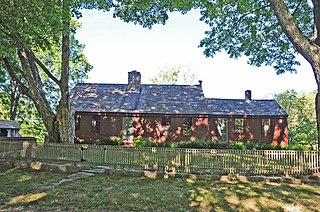
The Simon Lillibridge Farm is an historic farm property at 75 Summit Road in Exeter, Rhode Island. The 38-acre (15 ha) property is all that remains of an original 200-acre (81 ha) parcel purchased by Simon Lillibridge in the 1810s. The main house, a two-story wood-frame structure, was either built by Lillibridge, or was already on the property when he bought it. Architectural analysis of the house suggests that at least portions of it were built in the 18th century, with hand-hewn beams, and other stylistic elements suggesting construction during the Georgian period. The farm complex includes other 19th-century buildings, including a barn, shed, wagon shed, and outhouse, as well as a family cemetery. The property was in regular agricultural use until about 1935, and was used thereafter as a summer residence.

The Commodore Oliver Perry Farm is an historic farm on United States Route 1 in South Kingstown, Rhode Island. The farm consists of 250 acres (100 ha) of rolling fields and woodlands on the west side of the road. The main farm complex includes a wood-frame house, barn, a caretaker's residence, and a number of other outbuildings, accessed via a winding private lane. The main house, a two-story gambrel-roofed structure, is of uncertain construction date, and is generally dated to either 1785 or 1815. It has been extensively altered, and been the subject of well-meaning but historically problematic restorations in the first half of the 20th century.

The Spink Farm is a historic farm at 1325 Shermantown Road in North Kingstown, Rhode Island. The only surviving element of the farmstead on this 55-acre (22 ha) farm is the main house, a 2+1⁄2-story five-bay wood-frame structure built in 1798 by Isaac Spink. The house exhibits modest Federal styling, its doorway flanked by small sidelight windows and simple pilasters, and topped by a shallow hood. The interior follows a typical center-chimney plan, with its original Federal period fireplace mantels intact. The house has been extended to the rear by a kitchen ell and porch, both added in the 20th century. The house is one of a small number of 18th-century farmsteads left in the town.
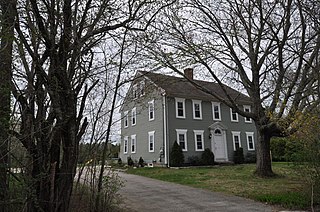
The Joseph Briggs House, also known as the Coventry Town Farm, is a historic house in Coventry, Rhode Island. The main block of the house, a 2+1⁄2-story wood-frame structure, was built c. 1790 by Joseph Briggs, and the property was purchased from his heirs in 1851 by the town for use as a poor farm. The town added a two-story ell to the rear of the house to provide additional housing space. The property is one of the few such poor farms to remain relatively intact. The farm was closed in the 1930s, after which the property fell into decline. It has since been rehabilitated as a two-family residence.

The Richard Briggs Farm is a historic farm at 830 South Road in East Greenwich, Rhode Island. The 72-acre (29 ha) farm, established in 1704 by Richard Briggs on land given to him by his father, who had acquired it in the 1670s. The farm is one of the oldest in the town, and is one of its few remaining farms that is still largely intact. Construction of the core of the main house, a 2+1⁄2-story timber-frame structure with a large central chimney, was traditionally ascribed to Briggs, but architectural evidence suggests it was built c. 1735–55, probably by Briggs' son John after his father's death. This structure has had two major additions, an ell to the west built c. 1820–50, and a northern ell built in the 1930s and further extended in following decades. The property includes a barn which may be contemporaneous to the original house.

Budlong Farm is an historic farmhouse in Warwick, Rhode Island. It is a 1+1⁄2-story wood-frame house, with a gambrel roof and a large central chimney. Its current entrance is asymmetrically placed on the north facade, although the original main entry was on the south side. The house was probably built sometime between 1700 and 1720 by John Budlong, whose family was one of the first to settle the area after King Philip's War. The property is a rare local example of architecture to survive from that period.

The Silas Clapp House is an historic house at East Greenwich Avenue in West Warwick, Rhode Island. The 2+1⁄2-story wood-frame house was built around 1797-1804 by Silas Clapp, who farmed a 100-acre (40 ha) parcel of land surrounding the house. It was thought to be built in 1804, but newspapers found in the walls are dated as early as 1797 and many at 1798, suggesting the house was built earlier than previously thought. It is a well-preserved example of vernacular Federal styling, with a five-bay main facade and a central entry with fanlight. There is a large central chimney, a feature more commonly found in older Georgian era homes. Descendants of Clapp owned the property until the 1880s.

Eveleth Farm is a historic farmstead on Burpee Road in Dublin, New Hampshire, United States. Built about 1823 and enlarged in 1980, it is a well-preserved example of an early hill farmstead, noted for its association with Henry David Thoreau, who visited the farm during a stay in Dublin in 1852. The house was listed on the National Register of Historic Places in 1983.





















